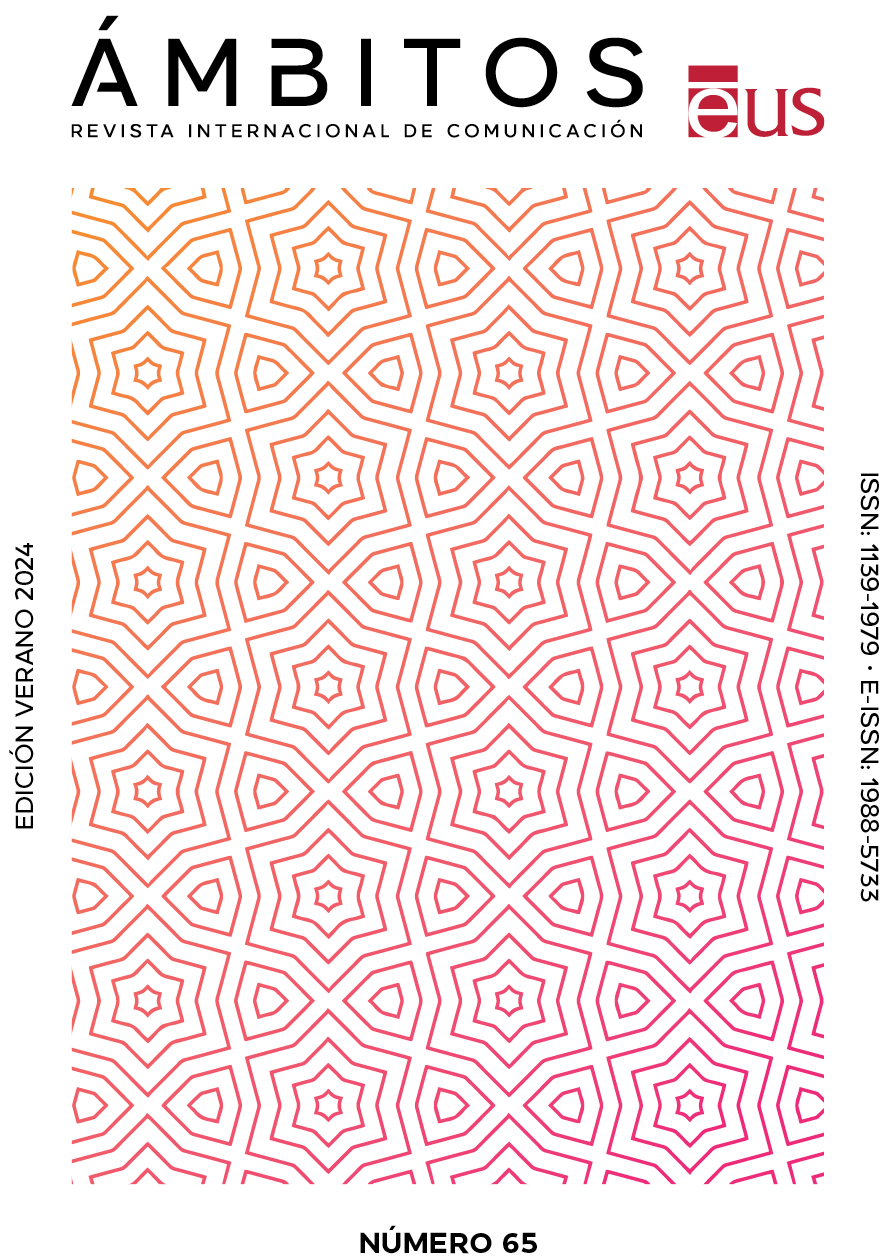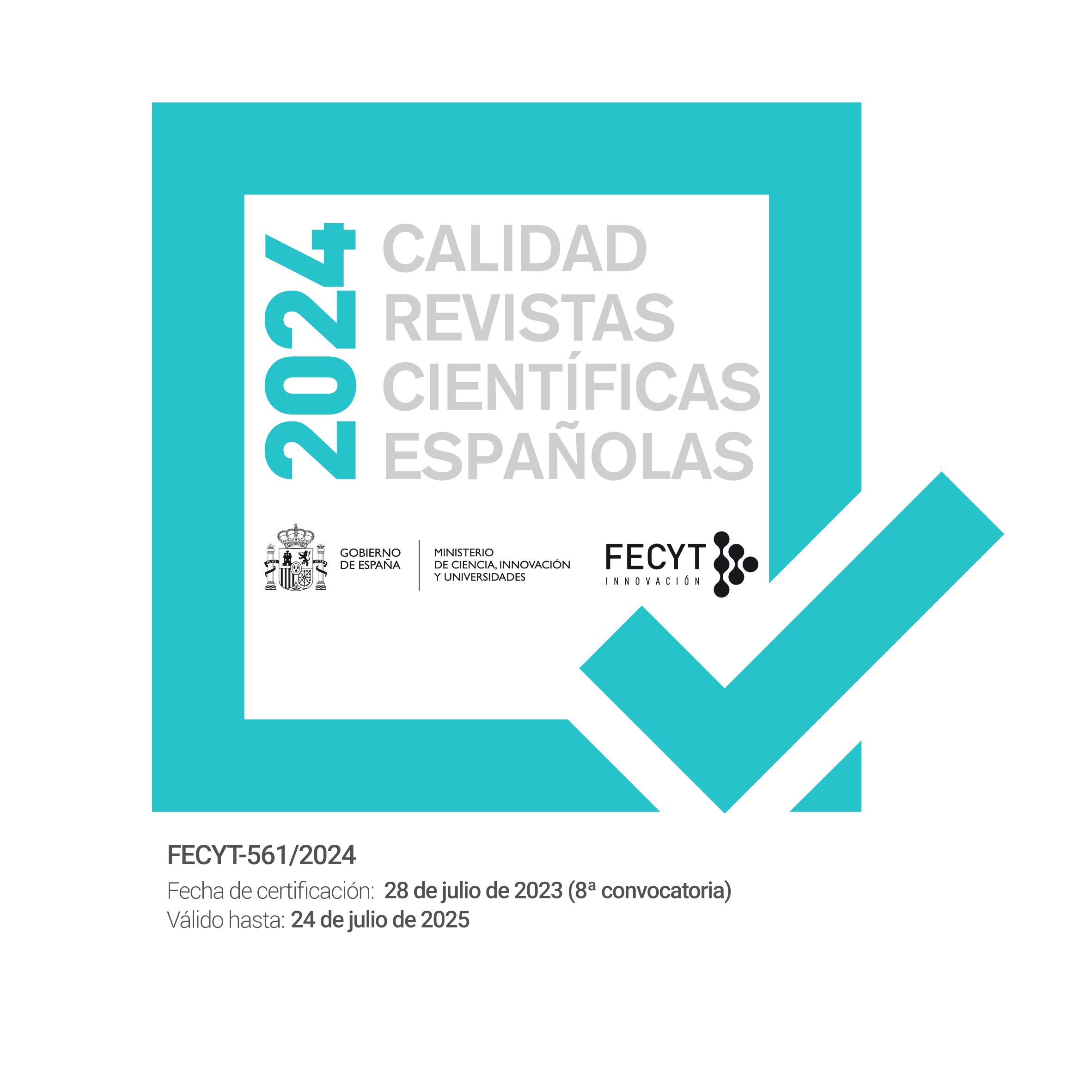#Discapacidad y #diversidadfuncional. Evolución terminológica desde la perspectiva de los creadores de contenido en TikTok
DOI:
https://doi.org/10.12795/Ambitos.2024.i65.01Palabras clave:
lenguaje inclusivo, discapacidad, diversidad funcional, TikTokResumen
El debate en torno a la evolución terminológica sobre la discapacidad ha llegado a las redes sociales. En este artículo se analizan discursos y percepciones de los creadores de contenido en TikTok, respecto a los términos correctos e incorrectos para referirse al colectivo de las personas con discapacidad, los tipos de contenidos generados en la plataforma y el uso de sus funcionalidades, finalidades y estrategias. El análisis se desarrolla con un método cuantitativo-cualitativo con enfoque etnográfico y un análisis multimodal sobre 100 vídeos cortos. Se realizó una búsqueda por hashtags y palabras clave entre diciembre de 2021 y enero de 2022. La investigación considera el modo en qué los creadores de contenido comparten su percepción sobre los términos que hoy se suelen utilizar para referirse a las personas con discapacidad y cuáles consideran adecuados e inapropiados. Los resultados evidencian el debate, los posicionamientos de los creadores de contenido y el activismo, señalándose la expresión “personas con discapacidad” como el término más aceptado y reconocido actualmente, mientras que entre los términos obsoletos, ofensivos y no representativos destacan “minusválido”, “subnormal” o “deficiente”. Otros hallazgos interesantes relativos a las funcionalidades de la plataforma son el uso de los vídeos respuesta, musicales y dúos, así como la utilización de hashtags como estrategia para alcanzar sus objetivos de formación y educación, visibilización y concienciación social. Así, a pesar de que se ha producido una evolución terminológica en torno a la discapacidad, se evidencia que todavía queda un largo camino para alcanzar el verdadero lenguaje inclusivo.
Descargas
Citas
Aguado-Díaz, A.L. (1995). Historia de las deficiencias. Escuela Libre Editorial/Fundación Once.
Alemany, M. (2021). Should we say «functional diversity» to refer to «disability»? A critique of the new postulates of political correctness around disability. Law and the Janus-faced Morality of Poltical Correctness, (1), 109-132. https://doi.org/10.14195/2184-9781_1_5
Andrade-Vargas, L., Iriarte-Solano, M., Rivera-Rogel, D., & Yunga-Godoy, D. (2021). Young people and social networks: Between the democratization of knowledge and digital inequality. [Jóvenes y redes sociales: Entre la democratización del conocimiento y la inequidad digital]. Comunicar, 29(69), 85-95. https://doi.org/10.3916/C69-2021-07
Avendaño, M.Y., García-Barrera, A.E., & Naranjo-Muñoz, M.L. (2014). Representaciones sociales de las personas con diversidad funcional. Revista Inclusiones, (1), 169-176. https://bit.ly/3tNuTgh
Ávila-Ramírez, R., & Rivas-Carmona, M.M. (2022). El lenguaje peyorativo y la discapacidad. In S.A. Flores-Borjabad, O.S. Ould García & A. Garcés Manzanera (Coords.), El devenir de la lingüística y la cultura: Un estudio interdisciplinar sobre lengua, literatura y traducción (pp. 294-313). Dykinson. https://bit.ly/4b1ry06
Ballesteros-Herencia, C.A. (2020). La propagación digital del coronavirus: Midiendo el engagement del entretenimiento en la red social emergente TikTok. Revista española de comunicación en salud. (Sup.1), 171-185. https://doi.org/10.20318/recs.2020.5459
Bezemer, J. & Kress, G. (2017). Young People, Facebook and Pedagogy: Recognizing Contemporary Forms of Multimodal Text Making. In M. Kontopodis, C. Varvantakis & C. Wulf (ed.). Global Youth in Digital Trajectories. Routledge. https://bit.ly/36JZKlc
Bonilla-Del-Río, M., Castillo-Abdul, B., García-Ruiz, R., & Rodríguez-Martín, A. (2022). Influencers With Intellectual Disability in Digital Society: An Opportunity to Advance in Social Inclusion. Media and Communication. 10(1), 222-234. https://doi.org/10.17645/mac.v10i1.4763
Bonilla-Del-Río, M., García-Ruiz, R., Aguaded, I., & Muñoz-Borja, P. (2021). Activismo digital y diversidad social. Focos de interés para la educación mediática. En M.C. Tornay-Márquez., I. Sánchez-López & D. Jaramillo-Dent (Coords.) Inclusión y activismo digital: participación ciudadana y empoderamiento desde la diversidad (pp. 9-27). Dykinson. https://bit.ly/3tTT3Wk
Cáceres, P. (2003). Análisis cualitativo de contenido: una alternativa metodológica alcanzable. Psicoperspectivas. Individuo y sociedad, 2(1), 53-82. https://bit.ly/3WyOPT3
Canimas-Brugué, J. (2015). ¿Discapacidad o diversidad funcional? Siglo Cero, 46(2), 79–97. https://doi.org/10.14201/scero20154627997
Comp, G., Dyer, S., & Gottlieb, M. (2021). Is TikTok the next social media frontier for medicine? AEM Education and Training, 5(3). https://doi.org/10.1002/aet2.10532
European Commission (2021). #UnionOfEquality European Commission Guidelines for Inclusive Communication. https://bit.ly/3tOn5Lp
Ferreira, M.A. (2010). “De la minusvalía a la diversidad funcional: un nuevo marco teórico-metodológico”. Política y Sociedad, 47(1), 45-65. https://bit.ly/36ynw3E
Figuereo-Benítez, J.C; García-Prieto, V. & Bonilla-Del-Río, M. (2023). Percepción de las organizaciones de personas con discapacidad sobre el tratamiento mediático del colectivo en espacios informativos. ICONO 14, Revista de comunicación y tecnologías emergentes, 21(2). https://doi.org/10.7195/ri14.v21i2.2018
García-Prieto, V., Bonilla-Del-Río, M. Y Figuereo-Benítez, J. C. (2024). «Discapacidad, discursos de odio y redes sociales: Video-respuestas a los haters en TikTok». Revista Latina De Comunicación Social, (82), 1-21. https://doi.org/10.4185/rlcs-2024-2258
Gray, J.E. (2021). The geopolitics of» platforms: The TikTok challenge. Internet Policy Review, 10(2), 1-26. https://doi.org/10.14763/2021.2.1557
Hine, C. (2005). Virtual methods. Issues in social research on the internet. Berg Publishers. https://doi.org/10.5040/9781474215930
Hine, C. (2015). Ethnography for the Internet. Embedded, Embodied and Everyday. Routledge. https://doi.org/10.4324/9781003085348
Hjorth, L. & Horst, H., Galloway, A., Bell, G. (2017). The Routledge Companion to Digital Ethnography. Routledge. https://doi.org/10.4324/9781315673974
Jaramillo-Dent, D., Contreras-Pulido, P., & Pérez-Rodríguez, A. (2022). Immigrant Influencers on TikTok: Diverse Microcelebrity Profiles and Algorithmic (In)Visibility. Media and Communication. 10(1), 208-221. https://doi.org/10.17645/mac.v10i1.4743
Martín-Ramallal, P., & Micaletto-Belda, J.P. (2021). Tiktok, red simbiótica de la generación z para la realidad aumentada y el advergaming inmersivo”. Revista de Comunicación, 20(2), 223-242. https://doi.org/10.26441/RC20.2-2021-A12
Méndez-Majuelos, I., López López, P. J. & Sobrados-León, M. (2023). TikTokers y discapacidad. Entretenimiento, inclusión y difusión de valores entre los jóvenes de habla hispana. ICONO 14, Revista de comunicación y tecnologías emergentes, 21(2). https://doi.org/10.7195/ri14.v21i2.2026
Mendiguren-Galdospin, T., Meso-Ayerdi, K., Pérez Dasilva, J.Á., Ganzabal-Learreta, M., Larrondo-Ureta, A., & Peña-Fernández, S. (2023). Twitter y el activismo por la discapacidad: liderazgo y temas relevantes en la conversación en red. ICONO 14, 21(2). https://doi.org/10.7195/ri14.v21i2.2027
Ortega-Fernández, E., & Rodríguez-Hernández, J. (2021). Estrategia de comunicación de los cuerpos de seguridad a través de píldoras audiovisuales en TikTok: Policía Nacional y Guardia Civil en España. aDResearch ESIC. 25(25), 160-185. https://doi.org/10.7263/adresic-025-09
Padilla-Muñoz, A. (2010). Discapacidad: contexto, concepto y modelos. International Law, (16), 381-414. https://bit.ly/2XVyAjU
Palacios, A. & Romañach, J. (2008). El modelo de la diversidad: Una nueva visión de la bioética desde la perspectiva de las personas con diversidad funcional. Intersticios, 2(2), 37-47. https://bit.ly/3JZAk1d
Romañach, J. & Lobato, M. (2005). Diversidad funcional, nuevo término para la lucha por la dignidad en la diversidad del ser humano. En L. Álvarez Pousa, J. Villanueva, T. Barbenera Fernández, O. Reboiras Loureiro & J. Evans Pim (Coords.), Comunicación y discapacidades: Actas do Foro Internacional (pp. 311-330). https://n9.cl/xinaa
Ruiz-Méndez, M.R., & Aguirre-Aguilar, G. (2015). Etnografía virtual, un acercamiento al método y a sus aplicaciones. Estudios sobre las Culturas Contemporáneas. Época III, 21(41), 67-96. https://bit.ly/3kbBf3B
Schellewald, A. (2021). Communicative Forms on TikTok: Perspectives From Digital Ethnography. International Journal of Communication, 15(21). https://bit.ly/3kbBf3B
Senent-Ramos, M. (2020). Functional diversity or disability? Social and conceptual challenges of the new educational paradigms. Culture and Education, 32(1), 17-26. https://doi.org/10.1080/11356405.2019.1709397
Suárez-Álvarez, R., & García-Jiménez, A. (2021). Centennialsen TikTok: tipología de vídeos. Análisis y comparativa España-Gran Bretaña por género, edad y nacionalidad. Revista Latina de Comunicación Social, (79), 1-22. https://www.doi.org/10.4185/RLCS-2021-1503
Tejedor-Calvo, S., Cervi, L., Robledo-Dioses, K., & Pulido-Rodríguez, C.M. (2022). Desafíos del uso de TikTok como plataforma educativa: Una red multitemática donde el humor supera al debate. Aula abierta, 51(2), 121-128. https://doi.org/10.17811/rifie.51.2.2022.121-128
Vázquez-Barrio, T., Sánchez-Valle, M., & Viñarás-Abad, M. (2021). Percepción de las personas con discapacidad sobre su representación en los medios de comunicación. Profesional de la información. 30(1). https://doi.org/10.3145/epi.2021.ene.06
We Are Social/ Hootsuite (2021). Digital 2021. Global Overview Report. https://bit.ly/3qSOOZf
Zeng, J., & Abidin, C. (2021). #OkBoomer, time to meet the ‘Zoomers’: Studying the memefication of intergenerational politics on TikTok. Information, communication & society, 24(6), 2459-2481. https://doi.org/10.1080/1369118X.2021.1961007
Publicado
Cómo citar
Número
Sección
Licencia
Derechos de autor 2024 Mónica Bonilla-Del-Río, Antonella Di-Cintio, Amor Pérez-Rodríguez

Esta obra está bajo una licencia internacional Creative Commons Atribución-NoComercial-CompartirIgual 4.0.
Ámbitos. Revista Internacional de Comunicación es una revista de acceso abierto, lo que significa que todo su contenido está disponible gratuitamente para el usuario o su institución. Los usuarios pueden leer, descargar, copiar, distribuir, imprimir, buscar o enlazar con el texto completo de los artículos, o utilizarlos para cualquier otro fin lícito, sin solicitar permiso previo al editor o al autor. Esta definición de acceso abierto se ajusta a la Iniciativa de Acceso Abierto de Budapest (BOAI).

A menos que se indique lo contrario, todo el contenido de la edición electrónica se distribuye bajo una " licencia internacional Creative Commons Attribution-NonCommercial-ShareAlike 4.0 ". Puede consultar la versión informativa y el texto legal de la licencia aquí. Esto debe indicarse expresamente de esta manera cuando sea necesario.
En caso de aceptación del manuscrito, los autores ceden los derechos de la obra para su publicación a Ámbitos. Revista Internacional de Comunicación bajo el contrato de licencia Reconocimiento-NoComercial-CompartirIgual 4.0 Internacional (CC BY-NC-SA 4.0). Los autores conservan los derechos de autor y terceros están autorizados a copiar, distribuir y hacer uso de la obra, siempre que cumplan con los términos y condiciones establecidos en la licencia.
- Citar la autoría y la fuente original de publicación (revista, editorial y URL de la obra).
- No los utilice con fines comerciales.
- Si remezcla, transforma o crea a partir del material, debe publicar sus contribuciones bajo la misma licencia que el original.
Se puede encontrar más información en https://creativecommons.org/licenses/by-nc-sa/4.0/deed.es



















